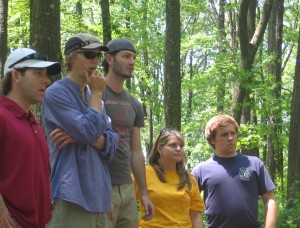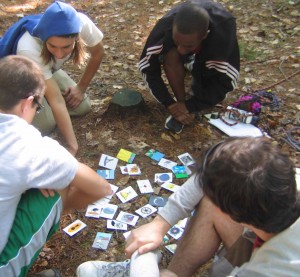
Jun 04, 2010 Processing in the Middle of the Experience
Processing in the Middle of the Experience
Jen Stanchfield
Often when we facilitate reflection with groups, we make time after the experience or lesson is completed to review and reflect. Many educators describe their reflective practice with groups as “debriefing”—a word that originated in the military for the act of eliciting a report from a soldier to officers after a mission was completed. I have never been a big fan of the term “debriefing” in the education field for many reasons, most importantly because it seems limiting. Reflection can be much more dynamic than sitting a group down after an activity to be questioned and report out to the facilitator.
About ten years ago during a conversation at a conference about group facilitation and processing, Luk Peeters, a therapist and experiential educator from Belgium, shared with me that he believes that the optimal place to capture a lesson is WHILE it is happening.
His comments really sparked my thinking about how to take advantage of those opportunities. I had been occasionally stopping groups in the midst of an activity to discuss and reflect, but usually only when things weren’t going well. I asked myself: Why not stop a group midway when things are going beautifully so they can remember what if felt like, looked like, and sounded like?

I started trying to weave in some brief “stop actions” in the midst of a challenge for groups to stop, look around, and identify what is working. Or, for a group that had struggled at the beginning and was now moving forward to identify what it was that had changed within their group process. It seemed that stopping in mid-activity allowed group members to take mental snapshots of key learnings and better apply them in subsequent activities. (In challenge course and other adventure learning situations make sure the group is in a physically comfortable/safe spot before stopping for this mid-activity reflection—so participants can fully attend to the conversation.)
One day not long after being inspired by Luk’s comments, I was facilitating a group of students in Middleton, Wisconsin’s High School challenge course class. I decided to place a set of Chiji cards on the middle “island” of the group “river crossing” challenge (see my last post for more information on card and object reflection activities).
My co-teacher Donna Richter and I were trying to adapt the challenge course activity “Nitro Crossing” so that 25 students would be able to participate safely and still feel challenged and involved throughout the experience. So we brainstormed ways to keep students spread throughout the “islands” so there wasn’t a lot of waiting at the swing rope area.
The students had a variety of tasks to complete on their island journey, including retrieving the swing rope they were using to cross to island one, building a puzzle “bridge” to get to island two, and transporting water to island two.
After contemplating the idea of having participants process mid-stream, we decided to set out a deck of Chiji (image cards) on the third island. As participants passed through island three, we asked them to use the cards to tell the story of their island journey. I was impressed by the student’s engagement in this task—the insights and observations they communicated about their group’s strengths, weaknesses, and goals—as they pulled together their story using the cards. The dialogue developed through the cards and story connected what they were learning with the real life issues of accomplishing school coursework, preparing for graduation and college, and working out conflict with peers. The story continued to develop as each group passed through island three. At the end of the activity, the group was excited to share the entire story (without any prompting from me or Donna).

As homework, we asked them to journal about their river crossing, and we found that the Chiji images and their connection to real-life goals were represented in many of the students journals. The next time the group engaged in a challenge together they seemed to be more adept at employing the skills and attributes they had discussed during the island crossing challenge.
After this experience, I continued to use metaphoric image cards and objects as a way to process “midstream” in a variety of ways (see last week’s post). This included laying out cards or objects at a transition point in the middle of a program and asking groups to come to agreement on three cards that represent three important skills they used in the activity that they think will be useful in upcoming activities. I often (especially with younger groups) have them carry these cards or objects with them to the next activity, and I’ve noticed they pull them out as a reminder, mid-activity, when the group starts falling into old habits. I often find a way to integrate them into the next activity or refer back to them to illustrate transfer of skills/learning to future situations.
Other opportunities for weaving reflection into the activity include using them in frontloading an activity. For example, having group members choose objects that represent goals for their program, workplace, or other situation and then making them part of the challenge itself in some way. There are many creative ways you can integrate reflective practice into the action phase of learning. Regardless of how you do it, I think you will find that groups engage in more meaningful reflective discussions spontaneously throughout their learning experiences if you “mix up” your approaches to facilitating reflection.
“In order for change to happen the optimal time is whilst experiencing and at that time being able to open up for the new or the not-alike. Afterwards we often ‘think’ we have learned something but in the next situation we do exactly as before, and that is because the actual emotional schemes that direct our behavior have not changed. It is like trying to change a software program in a computer. That is only possible if the computer is up and running.” -Luk Peeters



michael cardus
Posted at 05:24h, 05 JuneJen – learning and reading your works on processing & reflection has also served me in trying new techniques.
I remember when I first tried reflection during an initiative – I thought “this is brilliant!”
Now it is a standard.
Using a con-current reflection process allows teams to see what is going well and how to capitalize upon it.
Plus it moves thought patterns when the group is together (outside the simulation, ie desks, cubicles, classroom, board rooms) to perhaps pause a process discussion and explore what and how to improve an continue what is working.
L
Posted at 21:33h, 12 JuneReading this entry as we finished out day 3 of 5 weeks of summer staff training, it was a great reminder to keep things active and engaging.
I looooove using cards and PDFed a set of LOL cats (the internet meme with captions and animals together)…I call them LOLcards: lindsayfeldman.com/lolcards.pdf I like to use with groups that are less easily distracted (some 8th graders, 10th grade through college).
In lieu of debreif and reflection terms, I definitely like “processing”, because sometimes the group needs a quick reminder of goals, what worked, what didn’t, next challenge to keep practicing working with one another!
Glad to have you in the Twitterverse
L
ElleasinSwell
Sheila Bruns
Posted at 15:50h, 26 OctoberI am a little behind on the discussion, but I have tried this method since reading and I love it. I am currently working on my Masters in Education. I have found so many techniques that transfer seamlessly into the Experiential Education field – that to see this addition (formative asssessment) confirms that to isolate the two education fields limits us – I don’t believe we do that intentionally – my eyes have just been opened to the common goal of engaging students since taking classes… I love this newsletter.I
keith kelley
Posted at 08:54h, 17 MarchJen –
we have been working to regularly use reflection/processing time throughout the course of our training wilderness guides for youth programs in the Adirondacks – no matter what we are doing, we are mid-stream with something and a break to precess what is happening is, generally, welcome.
The chi-ji cards are a perfect (highly portable)support and catch participants imagination.